The feature review of the Duelund-Altec Project at Positive Feedback was published one year ago, on October 1, 2019, and today is the Duelund-Altec Project's one-year anniversary.
Now that I have a year's worth of experience and music listening under my belt with the Duelund CAST tinned-copper crossovers I installed into the "Stokowski" Altec loudspeakers, I thought this would be a good time for me to reflect back on the project, and provide my current impressions about their performance.
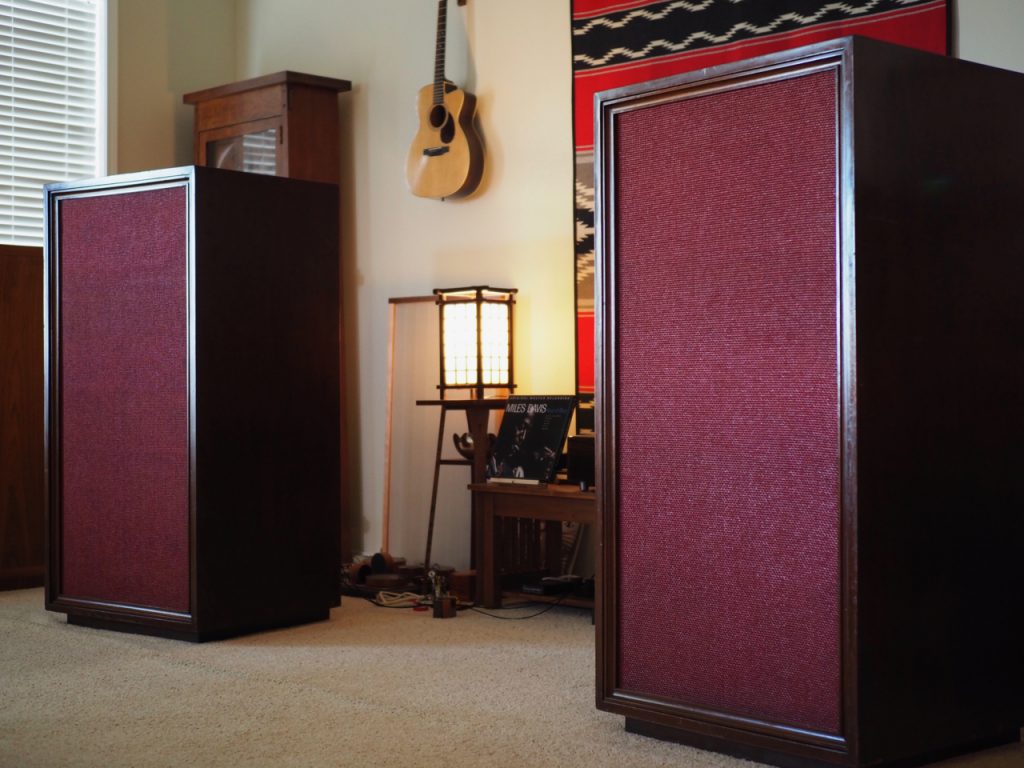
Leopold Stokowski's custom Altec loudspeakers.
The Duelund-Altec Project is easily the most remarkable audio project I've been involved in, due to the dramatic performance improvement brought about by the installation of the Duelund CAST tinned-copper crossovers into the vintage "Stokowski" Altec loudspeakers.
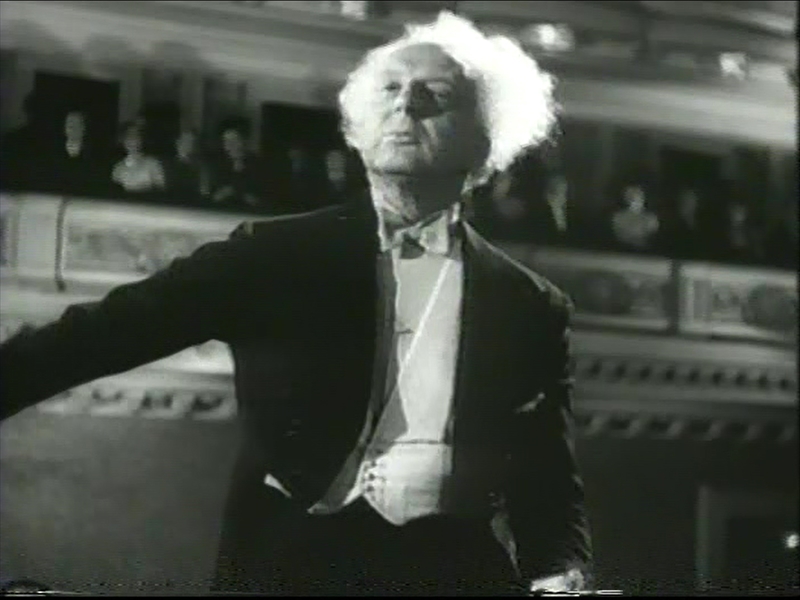
Leopold Stokowski at Carnegie Hall 1947 (public domain photo)
The project's nod to history, with the vintage Altec loudspeakers that were custom made in the early 1960s for conductor, musician, actor, film pioneer, socialite, and audio engineer, Leopold Stokowski, for his own home listening, would have been notable in itself, but the addition of a breathtaking world's first - the Duelund CAST tinned-copper crossovers - whose tinned-copper components were custom made by Frederik Carøe at Duelund Coherent Audio in Denmark specifically for this project, put the project into a rarefied audio realm.
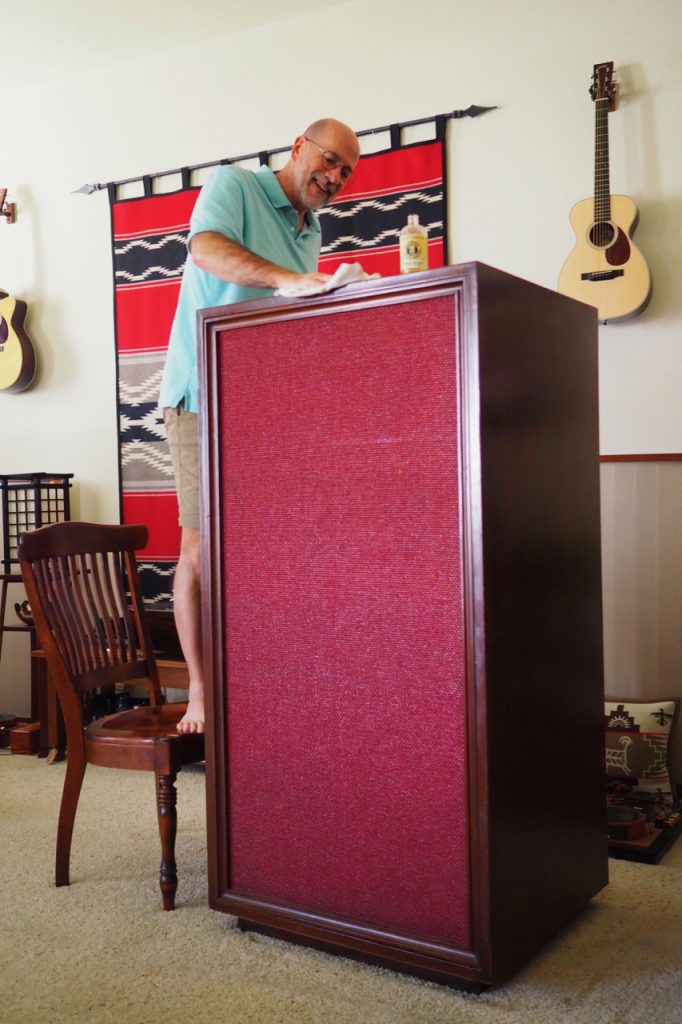
Polishing the "Stokowski" Altec cabinets with some Kramer's Best Antique Improver. I think I need more Kramer's!
In person, the first thing one notices about the "Stokowski" Altec loudspeakers is that they are big, even bigger than my Tannoy Westminster Royal Special Edition loudspeakers, as you can see in the above / below photos.
The "Stokowski" Altec loudspeakers measure 60 inches high by 30 inches wide by 26 inches deep, with a complement of Altec 803B low-frequency drivers, Altec 804A high-frequency compression drivers, Altec 511-B horns, and Altec N-500-D crossovers, all enclosed in massively braced custom wood cabinets that incorporate 825-style bass horn cabinets with an enclosed high-frequency horn cabinet, and fitted with burgundy grill cloth in massive wood frames.

My friend Chad with the Westminster and Stokowski Altec loudspeakers.
Prior to starting the Duelund-Altec Project, my friend Chad helped me move the "Stokowski" Altec loudspeakers into the Westminster's normal place in my living room, so we could give them a listen in their "as-built" form under familiar conditions.
The vintage "Stokowski" Altec loudspeakers were a rather startling revelation, in that they performed impressively even with their stock N-500-D crossovers, and in Chad's view, their as-built performance even surpassed that of my Tannoy Westminster Royal Special Edition loudspeakers - with their own Duelund-Westminster Project Duelund CAST crossovers - in their ability to provide a very live-like and engaging presentation of recorded music.
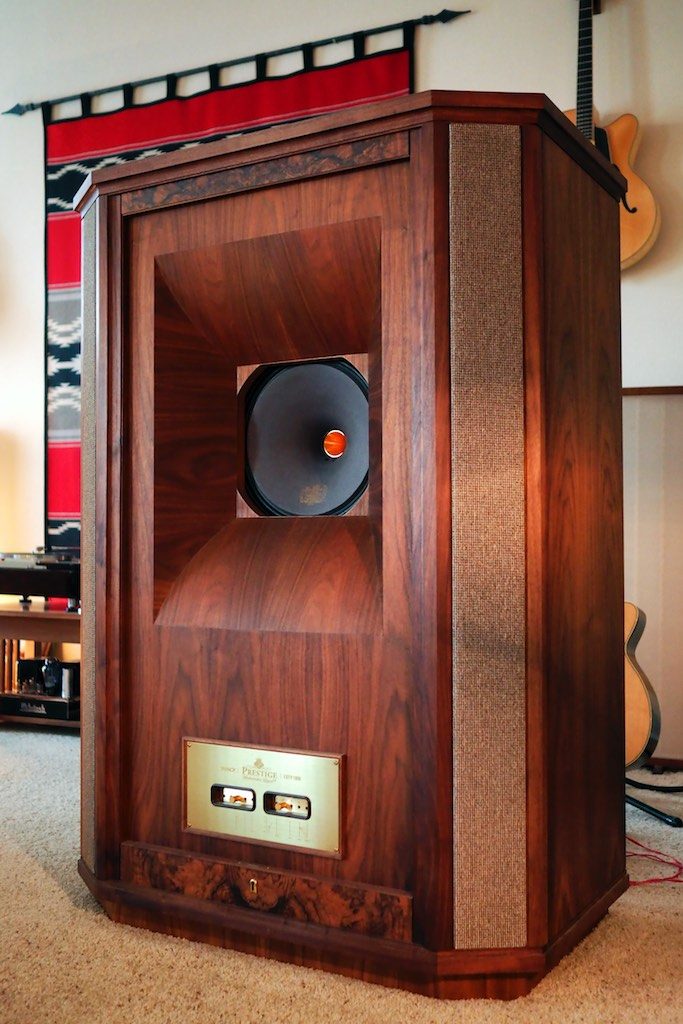
Tannoy Westminster Royal SE loudspeakers with Duelund CAST crossovers.
Even though the "Stokowski" Altec loudspeakers did sound impressive, particularly on the rock & roll music that Chad favors, I wasn't so sure that overall I agreed with Chad that the Altec loudspeakers bettered my Westminsters, as the big Westminster loudspeakers had greater high-frequency response, greater low-frequency response, and of course the superb coherency of the Tannoy Dual Concentric drivers. The Westminsters are extremely good loudspeakers, and I really enjoy what they're capable of.
However, as you will read in a moment, the installation of the Duelund CAST tinned-copper crossovers raised the "Stokowski" Altec loudspeakers' performance to astonishing levels in several key aspects of their performance, and I've come to agree with Chad that the "Stokowski" Altec loudspeakers now outperform my beloved Westminster loudspeakers in a number of ways, which I'll provide the details about in a moment.
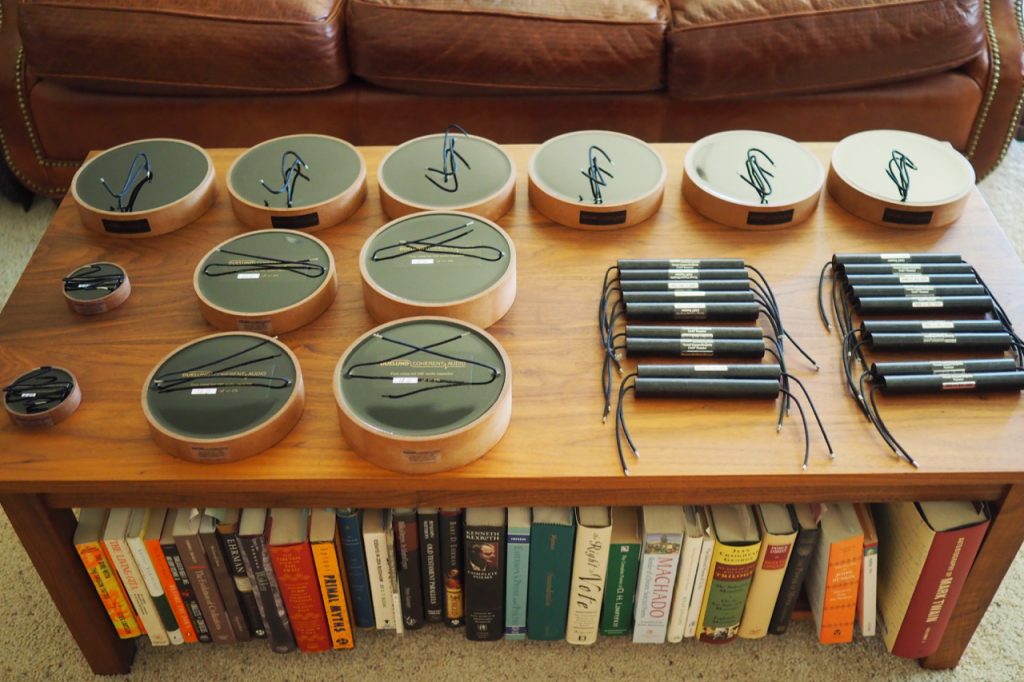
The arrival of the Duelund CAST Sn-Cu components used in the Duelund-Altec Project.
I had been eagerly awaiting the arrival of the Duelund CAST tinned-copper components after hearing the prototype Duelund CAST tinned-copper capacitors in my vintage Macintosh MX110 tuner-preamplifier's cathode follower stage, as they were a dramatic performance boost over any other capacitors in my experience.
Then I read Tony's review of the Duelund CAST tinned-copper 100V capacitors at Humble Homemade HiFi, which really got me going:
"With the Duelund CAST Cu-Sn all types of music flow, become more involving, to such an extent that I was forgetting that I was testing capacitors—I haven't had that experience for years."
Tony at Humble Homemade HiFi rates the capacitors in his reviews on a scale from 0 to 20 points, with better capacitors scoring 10 ± 3 points. The Duelund CAST tinned-copper capacitors scored 15 points, which is the highest rating ever achieved by a capacitor tested by Humble Homemade HiFi.

Duelund CAST tinned-copper crossovers based on a Hiraga-style Altec crossover circuit.
The crossover circuit I chose for the project was the Jean Hiraga circuit designed for 16 Ohm Altec drivers.
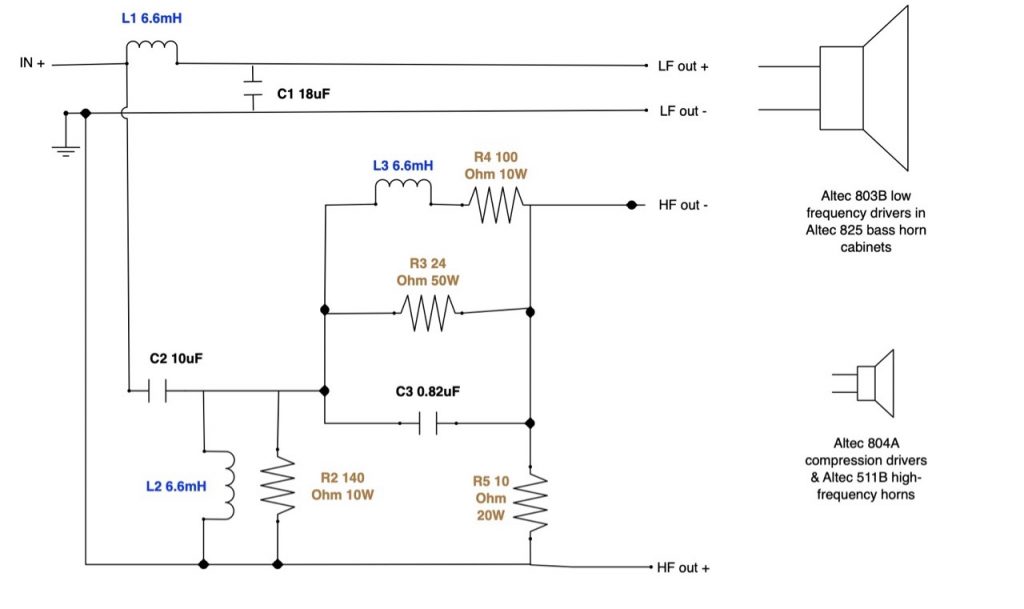
Jean Hiraga circuit for 16 Ohm Altec drivers.
After I assembled the crossovers, I then then installed them into the high-frequency horn cabinets of the "Stokowski" Altec loudspeakers.
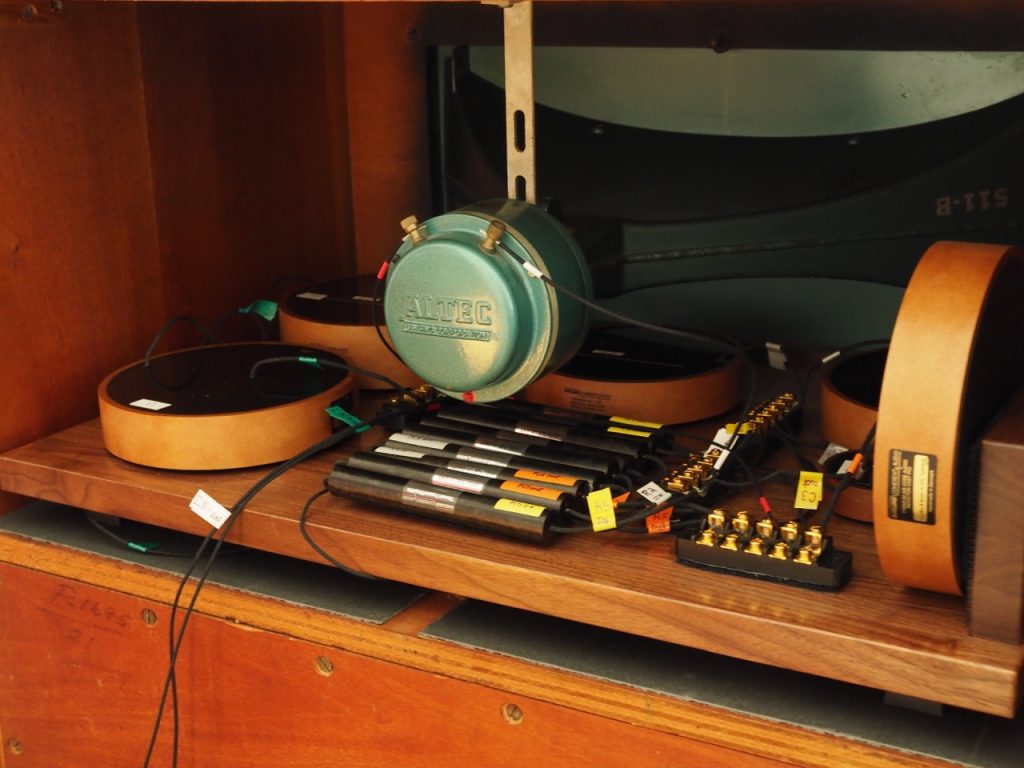
Duelund CAST tinned-copper crossovers installed into the "Stokowski" Altec loudspeakers.
Then I began my listening to the "Stokowski" Altec loudspeakers with the first of their kind, Duelund CAST tinned-copper crossovers, and immediately I was impressed by the results.
Let me provide you a quick introduction to the sound quality differences resulting from the use of different metal foils used in the construction capacitors (or inductors).
First of all, there's a number of metal foils that can be used in constructing paper-in-oil capacitors: aluminum foil, tin foil, copper foil, gold foil, silver foil, and tinned-copper foil.
For now, I'm only referring to those metal foils used by Duelund Coherent Audio in the CAST product lines, which are pure copper foils, pure silver foils, and now tinned-copper foils.
Copper is the baseline foil for constructing capacitors, and has a natural and well-balanced sound quality that most of us are quite familiar and enamored with, and it is relatively affordable for use in audio projects.
Silver foils produce a more transparent, resolving, and brightly lit sound quality that some people truly love, while others think it is a bit too much, and of course silver foil makes capacitors or inductors very, very, expensive to use in audio projects, which will be a limiting factor for its use for most people.
The new kid on the block is tinned-copper foils, and I think Tony at Humble Homemade HiFi wrote the best succinct description so far of its sound properties in his review of the Duelund CAST tinned-copper capacitors:
"With the Duelund CAST Cu-Sn all types of music flow, become more involving, to such an extent that I was forgetting that I was testing capacitors—I haven't had that experience for years."
Essentially, tinned-copper foils are distinctly different in their performance from pure copper or silver foils. Tinned-copper foils provide an open, natural, and engaging sound quality that I find to be completely unique, and somewhere in-between that of pure copper and pure silver, but with several characteristics that neither pure copper or pure silver foils possess: tinned copper foils provide an effortless and liquid presentation that enhances all kinds of music, while at the same time making music much more involving and satisfying to listen to.
The Duelund-Altec Project "Stokowski" Altec loudspeakers have had music playing through them for over a year now, and the CAST tinned-copper components are well run-in.
I have found that the Duelund CAST tinned-copper crossovers do something rather amazing with music, in that they not only possess high-resolution and transparency like Duelund CAST copper or silver components are known for, but they also have a unique effortless and liquid musicality that sounds so utterly natural and engaging that they left me searching for words to articulate their overall performance.
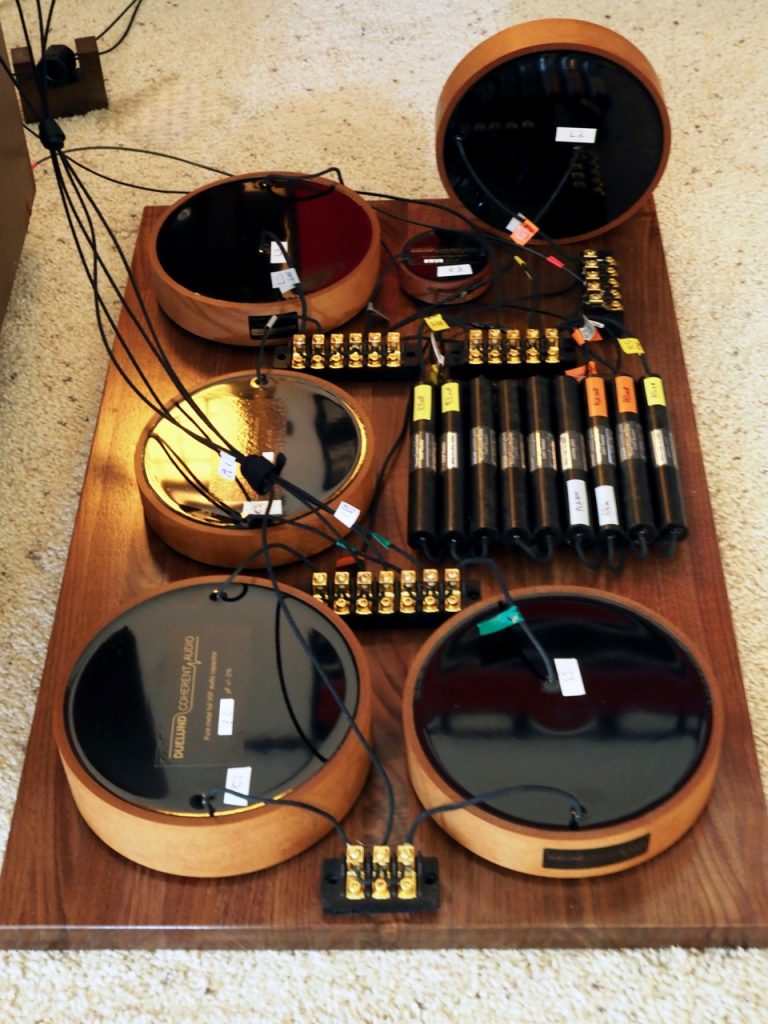
Duelund CAST tinned-copper crossover.
Over my past year of music listening and audio reviewing, I have been contemplating the performance of the "Stokowski" Altec loudspeakers with their Duelund CAST tinned-copper crossovers, and I am more impressed than ever with the passage of time.
Let me remind you of what Tony at Humble Homemade HiFi said so I can elaborate a little more on a couple of the points he mentioned:
"With the Duelund CAST Cu-Sn all types of music flow, become more involving, to such an extent that I was forgetting that I was testing capacitors—I haven't had that experience for years."
The "Stokowski" Altec loudspeakers, with their Duelund CAST tinned-copper crossovers, does all of those general performance attributes that deliver a satisfying home listening session superbly well, like providing beautifully natural tone, conferring a vivid life-like presence to the musicians on the soundstage, deliver effortless live-like dynamics across the dynamic spectrum, and they cast a billowing sense of the recorded acoustic space into my living room.
The intensity with which these loudspeakers and their crossovers deliver live-like musicality, seasoned with a beautifully rendered view of visuospatial recording artifacts, is unmatched in my experience with other loudspeakers.
And that's just their opening performance salvo, as there's much more going on performance-wise with them than that.
There's two traits that stand out in particular. The first is how good they are at playing all kinds of music.
For example, Tony articulated about how the Duelund CAST tinned-copper capacitors he tested allow "all types of music to flow".
That trait of allowing all types of music to flow, I have found to be a particular strength of the Duelund CAST tinned-copper crossovers, and it led me to coin the term "wide listening window" to describe the effect of how they make a much wider range of music satisfying to listen to.
Some speaker systems really limit what you can listen to, as only a fairly narrow range of really exceptional recordings sound musically engaging with them, with many albums of great music but average recordings sounding amusical.
The "Stokowski" Altec loudspeakers with the Duelund CAST tinned-copper crossovers are the opposite of that, they open a wide spectrum of albums you can listen to that doesn't limit a listener to a few audiophile favorites, while at the same time conveying a truly satisfying musical experience.
It doesn't really matter if I am listening to folk, jazz, classical, popular, or rock & roll music, from digital or analog sources, or even of recordings of varied quality from the eras of the acoustic horn recording era (1917-1924), the electrical recording era (1925-1940), the "modern" analog recording era (1941-1977), and now even the digital recording era. The "Stokowski" Altec loudspeakers with their Duelund CAST tinned-copper crossovers turn all of that music into truly pleasurable listening experience that leaves me lost in the music.
Another important aspect of Tony's comment is where he emphasizes all types of music, "... become more involving, to such an extent that I was forgetting that I was testing capacitors—I haven't had that experience for years."
That correlates well with another observation I have about the Duelund-zed "Stokowski" Altec loudspeakers strengths in music playback, which is that they provide the listener an intense connection to the emotive content of the music, more so than any other loudspeaker I am familiar with.
Think about that late-night listening session where you were listening to great music, and it totally blew you away on an emotional level.
That happens all day, every day, with pretty much any kind of music I care to listen to with the Duelund CAST tinned-copper crossovers and the "Stokowski" Altec loudspeakers.

Miles Davis, Ascenseur Pour L'Échafaud.
Take for example, Miles Davis' superb movie soundtrack recordings for the French movie Ascenseur Pour L'Échafaud.
Miles was doing something new with jazz in the soundtrack of Ascenseur Pour L'Échafaud, as he would watch scenes from the film and spontaneously play his trumpet in such a way as to capture the emotional sense of a particular scene, while it was being laid down on tape.
Miles wanted us to feel the emotional content of each scene the way he felt it by what he played on his trumpet. He wanted us to feel his feelings through his music.
Here's a great exercise for you to try while listening, ask yourself "What emotions do I feel while listening to this music?"
With the "Stokowski" Altec loudspeakers and their Duelund CAST tinned-copper crossovers, this sense of feeling what the musician is trying to convey as feelings, as emotions, as art becomes amplified in such a fashion that makes all music much more involving to listen to.
Great recordings are sublime, as you would expect from state-of-art Duelund CAST crossover circuit components, but what I find most striking is that the "Stokowski" Altec loudspeakers with their Duelund CAST tinned-copper crossovers allows for listening to even less than pristine recordings, which are presented with as much excitement, musicality, naturalness, and emotional impact as I get from those pristine audiophile-approved super recordings that we're all too familiar with.
I can still readily hear the differences in recording quality between different albums, yet the amusical nature of overtly audiophile-style audio systems that makes me want to put my hands over my ears with lesser recordings, is completely absent the "Stokowski" Altec loudspeakers with their Duelund CAST tinned-copper crossovers.
That's a big deal for me, as it opens up a whole new world of music listening possibilities to explore just for the fun of it.
What that ends up meaning in practical terms, is that I as a music lover can listen to a wide variety of real-world music with varied recording quality and still get a superbly satisfying musical listening experience that still sounds mind-blowingly good.
These speakers and their crossovers have allowed me to listen to pretty much whatever music I want, regardless of the recording quality, and enjoy it immensely without being distracted by the issues associated with recordings of lesser quality.
This trait has also held true across a range of audio components that I have listened to or reviewed over the past year.
Yes, differences in components are still easily audible, yet the "Stokowski" Altec loudspeakers with their Duelund CAST tinned-copper crossovers are seemingly able to get the best out of audio components of various designs in the same way they get the best out of a variety of recordings.
This particular trait reminds me of what happened when I had an opportunity to take photos with the really fast Leica Noctilux-M 50 f/0.95 ASPH lens on my Leica M9 camera at a camera show, where the subject of the photograph was presented with remarkable clarity and realism, while the busyness of the background took on a dreamy bokeh quality, that served to enhance the presentation of the subject of the photograph.
In somewhat similar fashion, the "Stokowski" Altec loudspeakers with their Duelund CAST tinned-copper crossovers present the music with remarkable clarity and realism, while recording artifacts that would normally be distracting or irritating get a touch of dreamy audio bokeh that actually enhances the presentation of the music instead of detracts from it.
It's not a perfect analogy, as the Duelund CAST tinned-copper crossovers still have high-resolution in terms of audiophile-style visuospatial effects like imaging, soundstage, sense of acoustic space, and the like, but those recording artifacts are rendered in such a natural fashion that they enhance - rather than detract from - the musical performance.
I've never heard a system that plays music so well and sounds so good as the "Stokowski" Altec loudspeakers with their Duelund CAST tinned-copper crossovers, and that is on pretty much anything I feel like listening to at any given time.
The "Stokowski" Altec loudspeakers with their Duelund CAST tinned-copper crossovers are the most musically satisfyingly loudspeaker-crossover combination I have ever encountered, anywhere, ever.
First of all, there's that whole "wide listening window" phenomena going on that allows me to listen to a wide variety of music of varying quality with complete satisfaction, along with that sense of immersive expansiveness, realistic scale and dynamics, and an utterly effortless and natural presentation of music, that all works together to provide an intimate connection to the emotional content of music to a degree I've never experienced before.
There's been days when I've been listening to how incredible this loudspeaker-crossover combination plays music that I've thought, "I'm finally where I want to be in this hobby, I'm done. I could stop writing about audio right now and move on to other interests without ever looking back."
I love to write about audio for you though, so I'm going to keep writing, but that's how profoundly all of this has impacted me.

Leopold Stokowski's custom Altec loudspeakers.
The Duelund-Altec Project has changed my perspective about what is possible in audio and the reproduction of recorded music in fundamental ways, and for the better.

Duelund CAST tinned-copper crossovers based on a Hiraga-style Altec crossover circuit.
Frederik Carøe has done something both amazing and new under the sun with the Duelund Coherent Audio product line of CAST tinned-copper components, which has redefined for me what I can expect to achieve in high-performance audio - this is a game changer product if there ever was one.
If you are thinking about building new high-performance crossovers for your loudspeakers, you should probably get in touch with Frederik about your ideas for your own Duelund CAST tinned-copper crossover project.
As always, thanks for stopping by, and may the tone be with you!



























